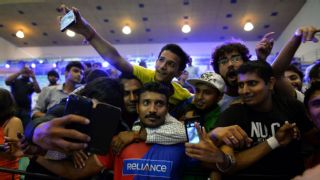|
It began with the adverts popping up for less than 20 seconds in between cricket matches and normal programming. A dark indoors, the drip of sweat, foot smashing chin, head hitting floor, man flying over men, a contorted face pushing through arms and shoulders, like a Mumbai train commuter trying to board the 8:03am CST Fast. I knew what these high-quality 'teasers' were about. Charu Sharma, fellow traveller and friend from Indian sport, had mentioned a kabaddi league in the making. Bubbling with the get-go, Charu was convinced the kabaddi league was going to be a cliché-busting barrier-breaker. Whenever I bumped into him, he was always ebullient but, with every successive appearance, more exhausted. When the teasers turned up, it was a sign that his league was a go. In mid-2014, the other mini-IPLs - hockey, badminton, boxing, football, golf, volleyball - had scrabbled for notice. Tennis was to have two leagues and they both tanked. Kabaddi was to be yet another attempt, not so much out of the box as beyond it - a mystery container launched out into the open seas. An indigenous working-class sport - in city and village - kabaddi was way beyond the boundaries of what was considered urban cool, far removed from the gaze of the TRP-generating-ad-magnet Indian purchasing classes. But that kabaddi we knew was the blurred single-cam desultory DD version. What burst onto Indian TV screens on July 26, 2014 was a contact sport of speed, athleticism, physicality and simplicity. Spruced up and knocked into shape with the mirror that television holds up to everything it wants to consume. It came armed with the required bells and whistles: 18 cameras, loud bass music to punctuate the action, hollering commentators, fog machines spewing out smoke and its own language and groove. Twenty minutes per half, forty minutes per match, everything said and done in an hour. Two matches per night. When PKL began I was hooked. Not by its loud embroidery, but the sport itself and its sheer full-contact fearlessness. Kabaddi had been described as a "combination of tag and wrestling" but that description ignored the sport's dramatic, gymnastic dexterity. The ability of its best athletes to torque their bodies in and out and over trouble, leaping, flying, diving through a mass of grabbing hands and stamping legs. What was unmissable was the nonchalance of its best; there they were, country boys of all shapes and sizes (maximum weight limit: 85kg) jaws strapped and heads bandaged, plunging into the action again. Emerging from under a scrum of bodies, checking their teeth to see if all were still in place and then returning to raid in the next 45 seconds. The first rounds of games were watched as fan, journalist, anthropologist and nit-picker. Charu would get messages during matches: The scoreline graphics are not clear. Why is the score in black numbers? White shows up better with the indoor background. (Or the other way around). The numbers are too small. Why are both teams dressed in shades of blue? It's confusing on TV. Maybe they should have different strips like they do in football. Big deal. There are now three teams (out of 12) dressed in various blues and the total auction spending has risen from Rs 4.7 crores for the first season to a total player purse of Rs 48 crore in the Season 6 auction. Kindly avoid sports marketing as a career option. In this life or the next. I still find PKL's action riveting and have tried to tune in every day of every season since - even if I can only watch the second half of the second match that night. The Hindi commentary has remained more insightful than the English. Older players always tell you more. There is no favoured team - Patna have always been strong, Gujarat were outstanding on debut - nor a favourite player. But by the end of PKL 1, I'll recognise them and their quirks and discover their backstories. Captain Rakesh, Anup, Ajay Thakur, Kashiling, Jasvir, Shabeer Bappu, Manjeet Chillar. Rahul Chaudhari -- and the foreign players pronounced in a single kabaddi breath: "Jangkunlee", "Fasalatrachali" My father, who played kabaddi in his UP schools in the 1940s, has watched PKL with me from the first season. A sports fan plus marketing man to the core, he appreciated the telegenic modification of the rules he'd known and has caught up with the new raid lingo - clock, super, do or die. You can tell the PKL is on, when kids in my Bangalore building start to play it amongst themselves, all through their free time. Not cricket, not football, not badminton. Kabaddi. A sport they wouldn't have known about five years ago.  Every season, the PKL has kept adding dinky changes - from number of teams (from 8 to 12 in Season 5) and the zonal format to setting up a highly popular juniors event. It keeps putting more and more plates into a spin and the fans remain mesmerised because the sport itself remains exciting. (But we haven't forgotten that the women's kabaddi challenge has vanished without explanations, either then or now.) What cannot be denied is that the PKL has done what no other Indian sport outside cricket could do with their version of a franchise league. Give the sport a remodelled form, translate its vocabulary into English and tie everything together into a watchable, sellable, instantly accessible package. Also, I miss no chance to remind people that Shikhar Dhawan's signature thigh-slap after taking a catch is borrowed from the PKL and the corny title they gave the gesture: the thigh-five. Season 6 is upon us and the PKL fan in me is waiting for the tumult to be unleashed. The journalist wants to know whether there will be some informed chatter about India's Asian Games performances or whether PKL will resort to some Indian-cricket-grade-pussyfooting (oh, boo!). And of course, Mr Big Buckeroos, Monu Goyat, everyone will be watching you.
|

